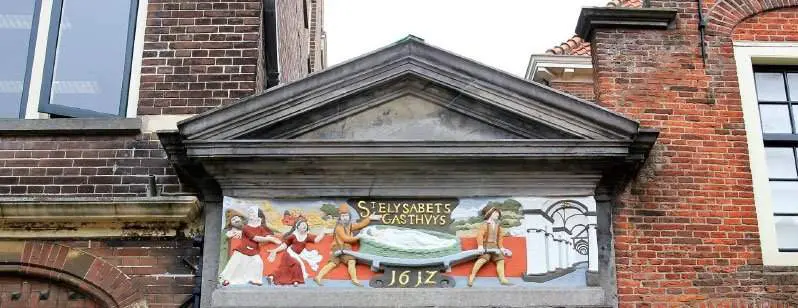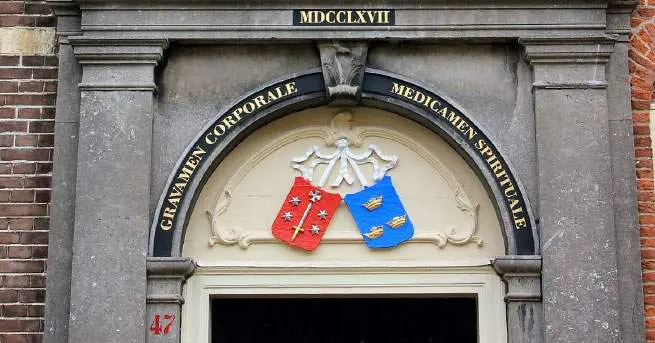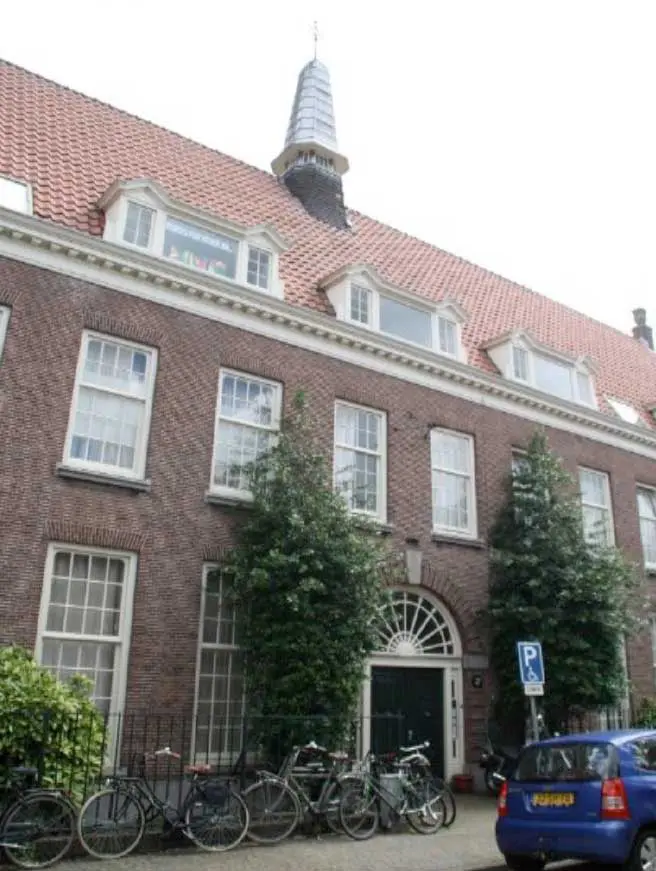
Tour around the former Sint Elisabeths or Groote Gasthuis
Verwey Museum Haarlem is located in the former Sint-Elisabeths or Groote Gasthuis. After the original Sint-Elisabeths Gasthuis (on the Verwulft) went up in flames during the great city fire in 1576, a new hospital had to be built. In 1597, the Gasthuis moves into the old building of the Minderbroedersklooster between Kleine Houtstraat and Groot Heiligland. Hospitals are for the poor; wealthy citizens are nursed at home.
When the building became too small after the Second World War, plans were made for new construction in the polders south of the then city border. In 1971 the EG (Elisabeth Gasthuis) moves to Schalkwijk and after a number of mergers it is renamed Spaarne Gasthuis.
To give you insight into the history of this extensive building, in which Verwey Museum Haarlem has been established since 1990, we offer you this circular walk of approx. 15 minutes. The start is outside in front of the museum entrance.
Museum entrance
The name of the hospital is still above the entrance. As with the Grote or Sint-Bavokerk on the Grote Markt, there is a Catholic and a non-religious variant. The hospital owes its name to Elisabeth, who was born in Hungary in 1207. At the age of fourteen she married Landgrave Lodewijk van Thüringen. During a famine, she takes the fate of the poor and sick to heart and offers help. Elisabeth of Thuringia dies at age 24. After her death she is canonized. She becomes the patroness of charity, of hospitals, beggars and desperate people. On the copper plaque above the entrance to the museum, Elisabeth stands among those in need, both Catholics and non-believers. Everyone was welcome. Many hospitals in Europe bear her name. Walk to the right until you see this Gasthuispoort.

Gasthuispoort and facing bricks
The top, recently restored, gable stone depicts the city fire of 1576. You can see how paramedics transport a patient in a carrying basket, from the burning city on the left to the new hospital on the right, followed by lamenting or fleeing people.
Below that MDCCLXVII (1767, year of construction of the gate) and on the arch the text: Gravamen corporale medicamen spirituale. This means: the suffering of the body is a cure for the mind.
Two weapons can be seen under the arch. The weapon of Haarlem (red) and that of the Sint-Elisabeths Gasthuis (blue) consisting of three crowns, these stand for Hungary, Bohemia and Thuringia and refer to Elisabeth of Thüringen.

Guest house or Proveniers houses
To the right of the gate are the twelve remaining Gasthuis or Proveniers houses. Twenty cottages are built between 1608 and 1616, which are for rent and in which residents can be nursed if they are ill. Building rental houses was a common form of investment for hospices in the seventeenth century. The houses are therefore one of the earliest examples of series construction. In 1906 eight houses to the left of the gate are demolished for the construction of the polyclinic (now used by the ABC Architecture Center and Museum Haarlem).
Continue past the houses and turn left at the end of the street.
The entrance to the building, which was completed in 1871, is located at the Gasthuisvest main building of the hospital. The coat of arms with the three crowns hangs in the gable stone high above the entrance. Until recently, the Egelantier cultural center was located here and the building will soon be converted into a hotel.
Walk on and turn left at Blender, into Kleine Houtstraat.
More than half of this street is on the left Guest house gate, the old entrance to the hospital. The foundations of the former Minderbroedersklooster can still be found under the inner garden. Until the beginning of the twentieth century, the garden contained wooden houses in which patients with infectious diseases were nursed.
Follow the walking path in the courtyard, walk out of the garden and turn left so that you are back in the Groot Heiligland.
Turn left until you see the former on the left Joles Hospital sees. The Star of David on the turret refers to its Jewish origins. Mozes Joles finances the hospital that opens in 1930 as the Jewish wing of the Sint-Elisabeths Gasthuis.

The hospital employs its own nursing staff and its own kitchen for kosher meals. The medical treatments are provided by the doctors of the Sint-Elisabeths Gasthuis. Few Jews were nursed. During the occupation, the wing is pulled near the general hospital.
If you walk a few more meters you will return to the starting point.
We hope you enjoy this walk!


